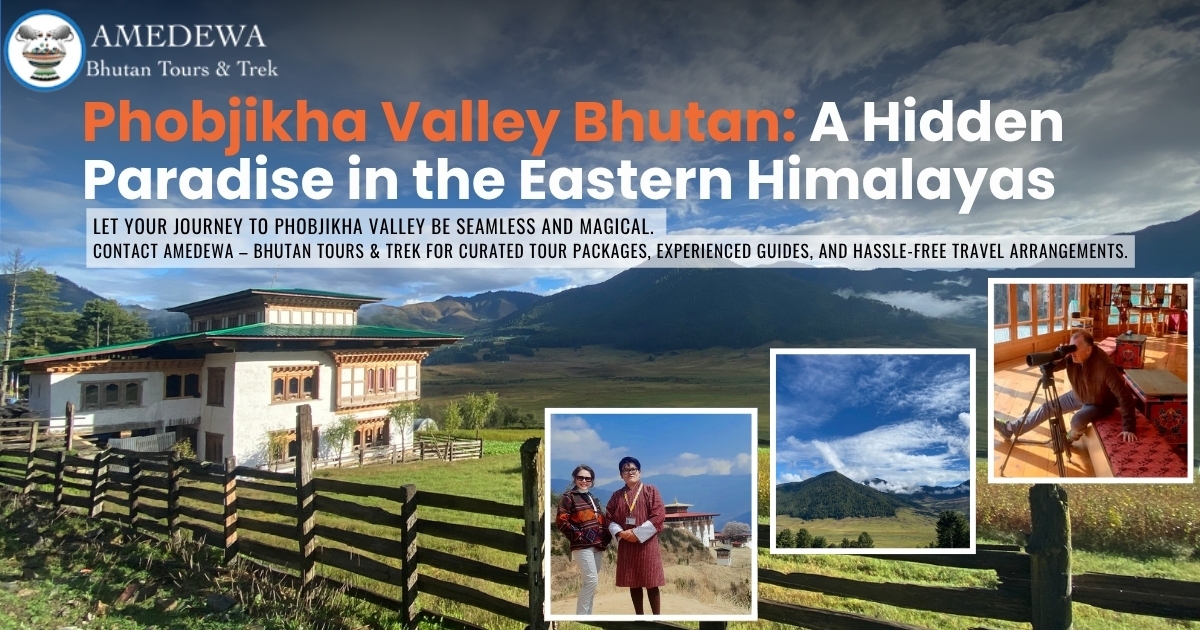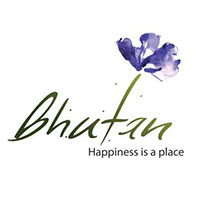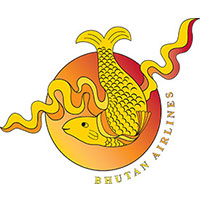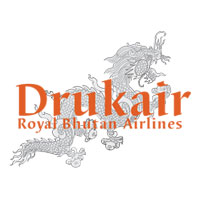Posted On: July 2, 2025 | By: adminadmin
Phobjikha Valley Bhutan: A Hidden Paradise in the Eastern Himalayas
Nestled in the arms of the Eastern Himalayas lies Phobjikha Valley Bhutan, a pristine glacial valley that remains one of the country’s best-kept secrets. Surrounded by dense pine forests and misty hills, this bowl-shaped valley is not just an ecological hotspot, but also a spiritual retreat rich in cultural heritage. Whether you are a nature lover, adventure seeker, or a cultural traveler, Phobjikha Valley tourism has something to offer everyone.
Let’s dive into a complete Phobjikha Valley travel guide and understand why this hidden paradise deserves a place on your Bhutan itinerary.
Why Visit Phobjikha Valley?
The charm of Phobjikha Valley lies in its untouched beauty and deep-rooted spirituality. Unlike the bustling cities, this region offers serene landscapes, traditional Bhutanese villages, and a slow-paced life steeped in tradition. This place remains deeply connected to its environment, evident in the valley’s role as a winter habitat for the rare black-necked cranes Phobjikha is famous for.
The valley also holds strong spiritual importance with the presence of Gangtey Monastery, one of the main centers of Nyingma Buddhism in Bhutan. For those seeking peace, nature, and culture, a spiritual tour Phobjikha promises a rejuvenating experience.
Things to Do in Phobjikha
If you’re planning your Phobjikha Valley tour plan, you’ll be surprised at the variety of experiences waiting for you. Here are the top things to do in Phobjikha:
-
Explore Gangtey Monastery
Perched atop a small hill overlooking the valley, Gangtey Monastery is one of Bhutan’s most important religious sites. The monastery complex offers panoramic views and gives visitors a chance to experience Bhutanese monastic life.
-
Spot Black-Necked Cranes
Every winter, from late October to early March, the valley becomes home to over 300 endangered black-necked cranes that migrate from Tibet. The Black-Necked Crane Information Centre is a great place to learn about conservation efforts and observe these graceful birds through telescopes.
-
Trekking in Phobjikha
The best way to experience the valley is on foot. Trekking in Phobjikha is ideal for beginners and nature lovers. The Gangtey Nature Trail, a 2-3 hour scenic walk, takes you through forests, farmlands, and quaint villages.
-
Experience Local Culture
Interact with villagers, visit traditional Bhutanese homes, and enjoy homemade butter tea and local delicacies. Participating in local festivals, like the Black-Necked Crane Festival, offers deeper insight into the valley’s unique blend of nature and culture.
-
Discover Wildlife in Phobjikha Valley
Besides cranes, the valley is also home to foxes, sambars, Himalayan black bears, and numerous bird species, making it a haven for wildlife enthusiasts.
Best Time to Visit Phobjikha Valley
The best time to visit Phobjikha Valley depends on your interests. If you’re keen on birdwatching, particularly the black-necked cranes, the winter months from late October to February are ideal. For lush green landscapes, spring (April to June) and autumn (September to November) offer clear skies and pleasant temperatures.
Avoid the monsoon season (July-August), as heavy rains may hinder travel and outdoor activities.
Phobjikha Valley Tour Plan
A well-structured Phobjikha Valley tour plan often includes:
- Day 1: Arrival at Paro or Thimphu, overnight stay.
- Day 2: Drive to Phobjikha via Dochula Pass (approx. 5-6 hours). En route, stop at Wangdue Phodrang.
- Day 3: Explore Gangtey Monastery, go for the Gangtey Nature Trail, visit local homes.
- Day 4: Birdwatching, visit the Crane Centre, relax in the valley.
- Day 5: Return to Paro/Thimphu.
The tour plan can be extended for trekking or cultural exploration.
Accommodations in Phobjikha
Phobjikha offers a range of accommodations, from traditional farm stays to boutique eco-lodges. Many guesthouses are locally run, ensuring you experience Bhutanese hospitality at its finest. Popular stays include Dewachen Hotel, Gakiling Guest House, and Gangtey Lodge (luxury category).
Travel Tips for Phobjikha Valley
- Altitude Awareness: The valley is located at an altitude of 3,000 meters. Take time to acclimatize if you’re arriving from lower elevations.
- Stay Warm: Even in summer, evenings can be chilly. Pack warm clothes.
- Respect Local Customs: Dress modestly and follow etiquette, especially around monasteries.
- Eco-Friendly Travel: As a protected area, visitors are expected to minimize waste and avoid disturbing wildlife.
How to Reach Phobjikha Valley?
Phobjikha is accessible by road from major cities in Bhutan:
- From Thimphu: 135 km (approx. 6 hours by road)
- From Punakha: 75 km (approx. 3 hours)
- From Paro: 180 km (approx. 7 hours)
The nearest airport is Paro International Airport. From there, you can hire a taxi or travel via an organized tour to the valley.
A Sustainable Future for Phobjikha
The valley’s fragile ecosystem has been preserved thanks to strict regulations and responsible tourism initiatives. Visitors are encouraged to support local conservation efforts, shop from community-run cooperatives, and stay in certified eco-lodges.
Phobjikha is a living example of how tourism, spirituality, and sustainability can go hand in hand.
Conclusion
Phobjikha Valley Bhutan is not just a place to visit—it’s an experience that touches your soul. With its stunning natural beauty, rich spiritual heritage, and commitment to sustainability, this hidden Himalayan paradise promises an unforgettable escape from the ordinary.
Whether you’re there to spot the majestic black-necked cranes, explore the wildlife in Phobjikha Valley, go trekking in Phobjikha, or seek inner peace on a spiritual tour, the valley will leave you inspired and rejuvenated.
Planning a Trip to Bhutan?
Let your journey to Phobjikha Valley be seamless and magical. Contact Amedewa – Bhutan Tours & Trek for curated tour packages, experienced guides, and hassle-free travel arrangements.
Get in touch today and unlock the serene beauty of Bhutan’s hidden paradise!





